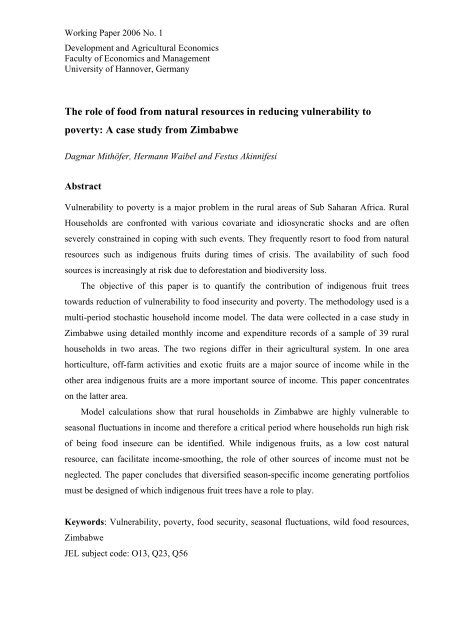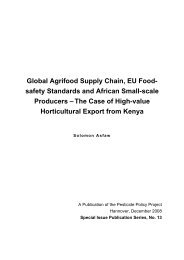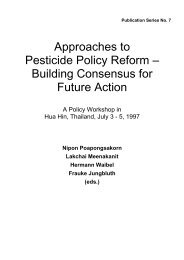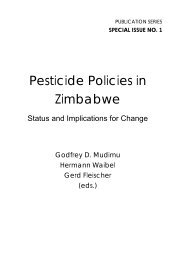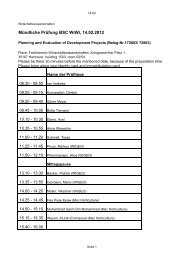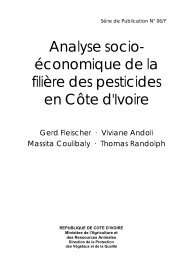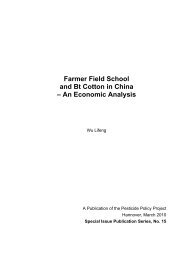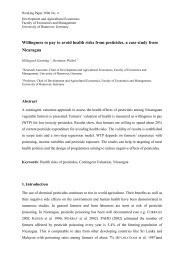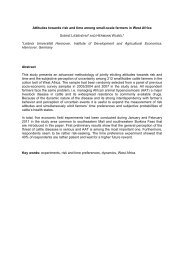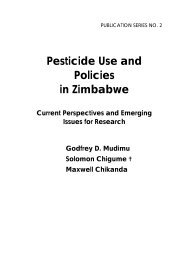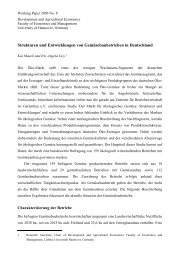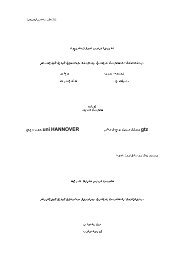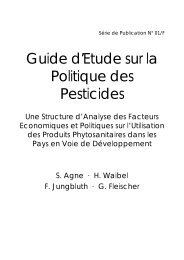The role of food from natural resources in reducing vulnerability to ...
The role of food from natural resources in reducing vulnerability to ...
The role of food from natural resources in reducing vulnerability to ...
You also want an ePaper? Increase the reach of your titles
YUMPU automatically turns print PDFs into web optimized ePapers that Google loves.
Work<strong>in</strong>g Paper 2006 No. 1<br />
Development and Agricultural Economics<br />
Faculty <strong>of</strong> Economics and Management<br />
University <strong>of</strong> Hannover, Germany<br />
<strong>The</strong> <strong>role</strong> <strong>of</strong> <strong>food</strong> <strong>from</strong> <strong>natural</strong> <strong>resources</strong> <strong>in</strong> reduc<strong>in</strong>g <strong>vulnerability</strong> <strong>to</strong><br />
poverty: A case study <strong>from</strong> Zimbabwe<br />
Dagmar Mithöfer, Hermann Waibel and Festus Ak<strong>in</strong>nifesi<br />
Abstract<br />
Vulnerability <strong>to</strong> poverty is a major problem <strong>in</strong> the rural areas <strong>of</strong> Sub Saharan Africa. Rural<br />
Households are confronted with various covariate and idiosyncratic shocks and are <strong>of</strong>ten<br />
severely constra<strong>in</strong>ed <strong>in</strong> cop<strong>in</strong>g with such events. <strong>The</strong>y frequently resort <strong>to</strong> <strong>food</strong> <strong>from</strong> <strong>natural</strong><br />
<strong>resources</strong> such as <strong>in</strong>digenous fruits dur<strong>in</strong>g times <strong>of</strong> crisis. <strong>The</strong> availability <strong>of</strong> such <strong>food</strong><br />
sources is <strong>in</strong>creas<strong>in</strong>gly at risk due <strong>to</strong> deforestation and biodiversity loss.<br />
<strong>The</strong> objective <strong>of</strong> this paper is <strong>to</strong> quantify the contribution <strong>of</strong> <strong>in</strong>digenous fruit trees<br />
<strong>to</strong>wards reduction <strong>of</strong> <strong>vulnerability</strong> <strong>to</strong> <strong>food</strong> <strong>in</strong>security and poverty. <strong>The</strong> methodology used is a<br />
multi-period s<strong>to</strong>chastic household <strong>in</strong>come model. <strong>The</strong> data were collected <strong>in</strong> a case study <strong>in</strong><br />
Zimbabwe us<strong>in</strong>g detailed monthly <strong>in</strong>come and expenditure records <strong>of</strong> a sample <strong>of</strong> 39 rural<br />
households <strong>in</strong> two areas. <strong>The</strong> two regions differ <strong>in</strong> their agricultural system. In one area<br />
horticulture, <strong>of</strong>f-farm activities and exotic fruits are a major source <strong>of</strong> <strong>in</strong>come while <strong>in</strong> the<br />
other area <strong>in</strong>digenous fruits are a more important source <strong>of</strong> <strong>in</strong>come. This paper concentrates<br />
on the latter area.<br />
Model calculations show that rural households <strong>in</strong> Zimbabwe are highly vulnerable <strong>to</strong><br />
seasonal fluctuations <strong>in</strong> <strong>in</strong>come and therefore a critical period where households run high risk<br />
<strong>of</strong> be<strong>in</strong>g <strong>food</strong> <strong>in</strong>secure can be identified. While <strong>in</strong>digenous fruits, as a low cost <strong>natural</strong><br />
resource, can facilitate <strong>in</strong>come-smooth<strong>in</strong>g, the <strong>role</strong> <strong>of</strong> other sources <strong>of</strong> <strong>in</strong>come must not be<br />
neglected. <strong>The</strong> paper concludes that diversified season-specific <strong>in</strong>come generat<strong>in</strong>g portfolios<br />
must be designed <strong>of</strong> which <strong>in</strong>digenous fruit trees have a <strong>role</strong> <strong>to</strong> play.<br />
Keywords: Vulnerability, poverty, <strong>food</strong> security, seasonal fluctuations, wild <strong>food</strong> <strong>resources</strong>,<br />
Zimbabwe<br />
JEL subject code: O13, Q23, Q56
1. Introduction<br />
Poverty is the major problem <strong>in</strong> rural areas <strong>of</strong> Sub Saharan Africa. In Zimbabwe <strong>in</strong> 1995, 48%<br />
<strong>of</strong> the rural population lived below the poverty threshold (Alwang et al., 2002). Many <strong>of</strong><br />
those, however, are at risk <strong>to</strong> fall deeper <strong>in</strong><strong>to</strong> poverty as a consequence <strong>of</strong> various types <strong>of</strong><br />
shocks. Likewise, people whose <strong>in</strong>come is above the poverty l<strong>in</strong>e may fall back <strong>in</strong><strong>to</strong> poverty.<br />
Hence, any analysis <strong>of</strong> poverty reduction measures must treat poverty <strong>in</strong> a dynamic context<br />
and identify risk-reduc<strong>in</strong>g strategies that lower the probability <strong>of</strong> people fall<strong>in</strong>g back or fall<strong>in</strong>g<br />
deeper <strong>in</strong><strong>to</strong> poverty. Generally, risk-management strategies such as diversification and <strong>in</strong>come<br />
skew<strong>in</strong>g aim at <strong>in</strong>come smooth<strong>in</strong>g <strong>from</strong> an ex-ante perspective. Risk-cop<strong>in</strong>g strategies <strong>in</strong>clude<br />
self-<strong>in</strong>surance like precautionary sav<strong>in</strong>gs, i.e. build<strong>in</strong>g up <strong>of</strong> assets, and group-based riskshar<strong>in</strong>g.<br />
<strong>The</strong>y deal with risk <strong>from</strong> an ex-post perspective and aim at consumption smooth<strong>in</strong>g<br />
(Dercon, 2000). <strong>The</strong> collection <strong>of</strong> wild <strong>food</strong>s is a commonly used risk-cop<strong>in</strong>g strategy by rural<br />
dwellers <strong>in</strong> develop<strong>in</strong>g countries. Wild <strong>food</strong>s, e.g. fruits, bush-meat, honey, mushrooms, etc.,<br />
are <strong>food</strong> <strong>from</strong> <strong>natural</strong> <strong>resources</strong>, which are collected <strong>in</strong> communal areas, along roads, etc.<br />
<strong>The</strong>y are an especially important <strong>in</strong>come source for poor people s<strong>in</strong>ce entry barriers for<br />
collection and use are low (Dewees, 1994). A variety <strong>of</strong> edible wild fruits are a popular<br />
<strong>natural</strong> resource <strong>in</strong> Southern Africa (Maghembe et al., 1998, Cavendish, 2000). <strong>The</strong>y are<br />
extensively used by the local population and, apart <strong>from</strong> own consumption; they are<br />
<strong>in</strong>creas<strong>in</strong>gly be<strong>in</strong>g sold <strong>in</strong> markets (Maghembe et al., 1998; Ramadhani and Schmidt, 2002).<br />
Indigenous fruits (IF) are available dur<strong>in</strong>g times <strong>of</strong> drought and fam<strong>in</strong>e, thereby contribut<strong>in</strong>g<br />
<strong>to</strong> <strong>food</strong> security (Rukuni et al., 1998; Mithöfer and Waibel, 2003). In the past, the fruits were<br />
a free good, but <strong>in</strong>creas<strong>in</strong>g shortage <strong>of</strong> the fruits has caused rivalry and competition<br />
(Ramadhani, 2002). Despite their <strong>role</strong> <strong>in</strong> susta<strong>in</strong><strong>in</strong>g <strong>food</strong> security, research and development<br />
has only recently recognized their importance. Wild harvest<strong>in</strong>g <strong>of</strong> forest products, especially<br />
fruits, is considered as a first major step <strong>in</strong> their domestication and commoditization (Simons<br />
and Leakey, 2004). <strong>The</strong>refore, research <strong>in</strong> the last decade has focussed on efforts <strong>to</strong><br />
domesticate <strong>in</strong>digenous fruit trees <strong>in</strong> addition <strong>to</strong> conservation strategies (Ak<strong>in</strong>nifesi et al.,<br />
2004).<br />
This paper analyses <strong>to</strong> what extent <strong>in</strong>digenous fruit tree products as currently available <strong>in</strong><br />
Zimbabwe make a contribution <strong>to</strong> reduc<strong>in</strong>g the <strong>vulnerability</strong> <strong>to</strong> poverty.<br />
Development and Agricultural Economics – Work<strong>in</strong>g paper 2006 /01 2
2. <strong>The</strong>oretical background and methodology<br />
Common measures <strong>of</strong> poverty are static. In contrast, <strong>vulnerability</strong> is a dynamic concept and<br />
captures the response <strong>to</strong> changes over time (Webb and Har<strong>in</strong>arayan, 1999; World Bank,<br />
2001). An <strong>in</strong>dividual’s or household’s exposure <strong>to</strong> risk fac<strong>to</strong>rs and their ability <strong>to</strong> cope with<br />
them determ<strong>in</strong>e the degree <strong>of</strong> <strong>vulnerability</strong>. Income risk and the failure <strong>to</strong> cope with it result<br />
<strong>in</strong> household consumption fluctuations. It affects nutritional, health and educational status as<br />
well as contribut<strong>in</strong>g <strong>to</strong> <strong>in</strong>efficient and unequal <strong>in</strong>tra-household allocations (Dercon, 2000).<br />
Vulnerability results <strong>from</strong> poverty, but at the same time can re<strong>in</strong>force <strong>in</strong>come processes and<br />
lead <strong>to</strong> poverty (Morduch, 1994). Information on fac<strong>to</strong>rs that determ<strong>in</strong>e <strong>vulnerability</strong> can help<br />
<strong>to</strong> design anti-poverty <strong>in</strong>tervention strategies.<br />
Several concepts <strong>of</strong> <strong>vulnerability</strong> have been suggested (Hodd<strong>in</strong>ott and Quisumb<strong>in</strong>g<br />
(2003) provide a review) <strong>in</strong>clud<strong>in</strong>g <strong>vulnerability</strong> as expected poverty (Pritchett at al., 2000),<br />
as low expected utility (Ligon and Schechter, 2003) and as un<strong>in</strong>sured exposure <strong>to</strong> risk<br />
(Glewwe and Hall, 1998). Vulnerability measures based on either assets or <strong>in</strong>come may not<br />
reflect households’ overall exposure <strong>to</strong> risk s<strong>in</strong>ce the <strong>to</strong>tal determ<strong>in</strong>es the capacity <strong>of</strong> a<br />
household <strong>to</strong> counteract risk (World Bank, 2001). Moreover, <strong>vulnerability</strong> is a dynamic<br />
process <strong>of</strong> cumulative conditions. Significance <strong>of</strong> causal fac<strong>to</strong>rs and their comb<strong>in</strong>ation change<br />
over time and place (Webb and Har<strong>in</strong>arayan, 1999). Fluctuations <strong>in</strong> <strong>vulnerability</strong> not only<br />
result <strong>from</strong> changes <strong>in</strong> causal fac<strong>to</strong>rs, but also <strong>from</strong> cop<strong>in</strong>g mechanisms available (Campbell<br />
et al., 2002).<br />
In this paper, follow<strong>in</strong>g Pritchett et al. (2000) <strong>vulnerability</strong>, Vu, is def<strong>in</strong>ed as expected<br />
poverty and is measured as the probability <strong>of</strong> fall<strong>in</strong>g below the poverty l<strong>in</strong>e, PL. <strong>The</strong><br />
magnitude <strong>of</strong> <strong>vulnerability</strong> <strong>in</strong>creases with the time horizon, t. A household, n, experiences a<br />
period <strong>of</strong> <strong>vulnerability</strong> if the household <strong>in</strong>come, Hi, is less than the poverty l<strong>in</strong>e 1 . Over m<br />
periods, the <strong>vulnerability</strong> is the probability <strong>of</strong> observ<strong>in</strong>g at least one period <strong>of</strong> poverty with<strong>in</strong><br />
those m periods, which is one m<strong>in</strong>us the probability <strong>of</strong> no period <strong>of</strong> poverty at any <strong>of</strong> the<br />
periods.<br />
n<br />
n<br />
Vu( m,<br />
PL)<br />
= 1−[(1<br />
− P(<br />
Hit < PL)) *...*(1 − P(<br />
Hit+ m<br />
< PL))]<br />
. (1)<br />
1<br />
Contrary <strong>to</strong> the def<strong>in</strong>ition above, Pritchett et al. (2000) def<strong>in</strong>e <strong>vulnerability</strong> based on expenditure and not<br />
on <strong>in</strong>come.<br />
Development and Agricultural Economics – Work<strong>in</strong>g paper 2006 /01 3
Poverty is usually measured based on cross section data, whereas measures <strong>of</strong> <strong>vulnerability</strong><br />
require panel data <strong>in</strong>clud<strong>in</strong>g <strong>in</strong>formation on household assets, formal and <strong>in</strong>formal safety nets<br />
and covariate and idiosyncratic risks that a household or <strong>in</strong>dividual is exposed <strong>to</strong>. S<strong>in</strong>ce panel<br />
data <strong>of</strong>ten is not available, this study uses a s<strong>to</strong>chastic household <strong>in</strong>come simulation model,<br />
which bases on cross section data <strong>from</strong> case studies <strong>in</strong> Zimbabwe.<br />
<strong>The</strong> household <strong>in</strong>come <strong>in</strong> period m is def<strong>in</strong>ed as the sum over gross marg<strong>in</strong>s, G ~ M , <strong>of</strong> all<br />
activities, a, plus additional cash, I ~ C , e.g. <strong>in</strong>formal loans, and the surplus carried over <strong>from</strong><br />
the previous period, m-1. <strong>The</strong> surplus <strong>from</strong> the previous period is that period’s household<br />
~<br />
<strong>in</strong>come, H i m− 1, net <strong>of</strong> household cash expenditure, E<br />
~ x m− 1<br />
, household consumption, Co m-1 , and<br />
~<br />
school fees, S F m− 1, <strong>of</strong> that period 2 (equation (2)). Household consumption is based on<br />
m<strong>in</strong>imum <strong>food</strong> requirements (= MFR) estimates <strong>from</strong> Alwang et al. (2002), which is ZWD 13<br />
per AEQ and day. Income flows and <strong>vulnerability</strong> <strong>to</strong> <strong>in</strong>come poverty depend on seasonal<br />
fluctuations, which are addressed by break<strong>in</strong>g the year down <strong>in</strong><strong>to</strong> several periods, m. ~<br />
denotes the s<strong>to</strong>chastic nature <strong>of</strong> <strong>in</strong>come and expenditure.<br />
~<br />
Hi<br />
m<br />
~ ~<br />
~ ~<br />
= Hi<br />
∑<br />
with IC = 0, if:<br />
A<br />
m− 1<br />
− Exm−<br />
1<br />
− Com−<br />
1<br />
− SFm−<br />
1<br />
+ GM<br />
am<br />
+ I Cm<br />
, (2)<br />
a=<br />
1<br />
~<br />
~<br />
Hi<br />
m<br />
~ ~<br />
~ ~<br />
= Hi<br />
∑<br />
A<br />
m− 1<br />
− Exm−<br />
1<br />
− Com−<br />
1<br />
− SFm−<br />
1<br />
+ GM<br />
am<br />
≥ Com<br />
+ Exm<br />
+ SFm<br />
,<br />
a=<br />
1<br />
~<br />
~<br />
and<br />
~<br />
Hi<br />
m<br />
A<br />
~ ~ ~ ⎛ ~ ~<br />
~ ~<br />
I C = Com<br />
+ Exm<br />
+ SFm<br />
− ⎜ Him−<br />
1<br />
− Exm−<br />
1<br />
− Com−<br />
1<br />
− SFm−<br />
1<br />
+ ∑ GM<br />
⎝<br />
a=<br />
1<br />
~ ~<br />
~ ~<br />
= Hi<br />
∑<br />
A<br />
m− 1<br />
− Exm−<br />
1<br />
− Com−<br />
1<br />
− SFm−<br />
1<br />
+ GM<br />
am<br />
< Com<br />
+ Exm<br />
+ SFm<br />
.<br />
a=<br />
1<br />
~<br />
~<br />
am<br />
⎞<br />
⎟ , if:<br />
⎠<br />
<strong>The</strong> assets carried over <strong>from</strong> the previous year and surplus available <strong>in</strong> t 0 is assumed <strong>to</strong> be<br />
equal <strong>to</strong> the surplus that households had accumulated by the end <strong>of</strong> the moni<strong>to</strong>r<strong>in</strong>g season <strong>in</strong><br />
2000. <strong>The</strong> model <strong>in</strong>corporates two specific risk-cop<strong>in</strong>g strategies: (1) households can access<br />
additional sources <strong>of</strong> cash, and (2) households can <strong>in</strong>crease <strong>in</strong>digenous fruit collection. All<br />
households have access <strong>to</strong> additional sources <strong>of</strong> cash, e.g. <strong>from</strong> a sav<strong>in</strong>gs account, with either<br />
2<br />
Note that, due <strong>to</strong> us<strong>in</strong>g gross marg<strong>in</strong>s for household <strong>in</strong>come calculations, the variable cost <strong>of</strong> production<br />
activities have already been accounted for.<br />
Development and Agricultural Economics – Work<strong>in</strong>g paper 2006 /01 4
own accumulated sav<strong>in</strong>gs or remittances and transfers <strong>from</strong> other family members, sav<strong>in</strong>gs<br />
clubs and <strong>in</strong>formal loans. <strong>The</strong>se <strong>in</strong>formal loans do not require collateral or charge <strong>in</strong>terest,<br />
similar <strong>to</strong> observations <strong>of</strong> other rural household surveys as also shown by Fafchamps and<br />
Lund (2002).<br />
Indigenous fruits are available dur<strong>in</strong>g the critical period, i.e. <strong>from</strong> August <strong>to</strong> January. In<br />
the model, whenever the household <strong>in</strong>come falls below m<strong>in</strong>imum <strong>food</strong> requirements plus cash<br />
requirements for production and household expenditure dur<strong>in</strong>g this period, the model<br />
household <strong>in</strong>creases fruit collection <strong>from</strong> the Communal Areas. However, the extent <strong>to</strong> which<br />
the household <strong>in</strong>creases fruit collection is limited <strong>to</strong> a contribution <strong>of</strong> 42% <strong>to</strong> the <strong>natural</strong> <strong>food</strong><br />
basket, which is the average across other studies (i.e. Campbell et al., 1997; Shackle<strong>to</strong>n and<br />
Shackle<strong>to</strong>n, 2000; Shackle<strong>to</strong>n et al., 2002; Shackle<strong>to</strong>n and Shackle<strong>to</strong>n, 2003).<br />
Receipt <strong>of</strong> remittances and the share <strong>of</strong> <strong>of</strong>f-farm activities reflect further riskmanagement<br />
and -cop<strong>in</strong>g strategies and are employed <strong>in</strong> the model up <strong>to</strong> the level found<br />
among the survey households. Cattle and poultry are most widely owned and are the ma<strong>in</strong><br />
assets sold (K<strong>in</strong>sey et al., 1998) 3 . From a risk-management perspective, the model captures<br />
the degree <strong>of</strong> <strong>in</strong>come diversification <strong>in</strong> the research location s<strong>in</strong>ce it uses <strong>in</strong>come data <strong>from</strong><br />
observed activities. By us<strong>in</strong>g gross marg<strong>in</strong>s, one <strong>in</strong>dica<strong>to</strong>r captures climatic, i.e. yield<br />
fluctuations, as well as market risk, i.e. price variability.<br />
In order <strong>to</strong> pool the cross-section sample for identify<strong>in</strong>g the distributions <strong>of</strong> each <strong>in</strong>come<br />
and expenditure category, adult equivalent units are used as common denom<strong>in</strong>a<strong>to</strong>r. <strong>The</strong><br />
distributions were fitted <strong>to</strong> the seasonal cross section data <strong>of</strong> each enterprise by us<strong>in</strong>g BestFit<br />
(Palisade, 2004) and the distribution with the best-fit statistic ranked by Chi-square test was<br />
employed. <strong>The</strong> model results for the seasonal household <strong>in</strong>come obta<strong>in</strong>ed <strong>from</strong> the<br />
simulations can be <strong>in</strong>terpreted as the <strong>in</strong>come <strong>of</strong> an average household <strong>of</strong> the research site.<br />
S<strong>in</strong>ce all households <strong>of</strong> the research location use <strong>in</strong>digenous fruits, no comparison<br />
between <strong>in</strong>digenous fruit users and non-users can be drawn. <strong>The</strong> latter implies that no<br />
‘without IF’ scenario can be def<strong>in</strong>ed. Thus, the contribution <strong>of</strong> IF <strong>to</strong>wards rema<strong>in</strong><strong>in</strong>g above<br />
the poverty l<strong>in</strong>e is assessed by subtract<strong>in</strong>g the IF <strong>in</strong>come <strong>from</strong> the household <strong>in</strong>come while<br />
hold<strong>in</strong>g all other fac<strong>to</strong>rs constant. <strong>The</strong> poverty model assesses three different scenarios<br />
depend<strong>in</strong>g on the degree <strong>to</strong> which <strong>in</strong>digenous fruits are used <strong>to</strong> substitute MFR.<br />
3<br />
This risk-cop<strong>in</strong>g strategy is not accounted for by us<strong>in</strong>g gross marg<strong>in</strong>s, s<strong>in</strong>ce the sale <strong>of</strong> lives<strong>to</strong>ck is<br />
counterbalanced by the reduction <strong>in</strong> s<strong>to</strong>ck. However, if this risk-cop<strong>in</strong>g strategy is <strong>to</strong> function <strong>in</strong> the long<br />
run, the sale <strong>of</strong> lives<strong>to</strong>ck has <strong>to</strong> occur at a lower rate than reproduction.<br />
Development and Agricultural Economics – Work<strong>in</strong>g paper 2006 /01 5
<strong>The</strong> model excludes dependency between the periods, e.g. <strong>in</strong>puts <strong>in</strong><strong>to</strong> agricultural and<br />
horticultural production <strong>from</strong> August <strong>to</strong> January as expressed by negative gross marg<strong>in</strong>s,<br />
which could be expected <strong>to</strong> result <strong>in</strong> higher gross marg<strong>in</strong>s dur<strong>in</strong>g harvest<strong>in</strong>g time <strong>from</strong> March<br />
through <strong>to</strong> June. Neglect <strong>of</strong> these dependencies can be <strong>in</strong>terpreted as the risk <strong>of</strong> crop failure,<br />
e.g. due <strong>to</strong> averse climatic conditions <strong>in</strong> the latter half <strong>of</strong> the cropp<strong>in</strong>g period. If a farmer<br />
plants her crops <strong>in</strong> the beg<strong>in</strong>n<strong>in</strong>g <strong>of</strong> the wet season and uses rather high quantities <strong>of</strong> <strong>in</strong>puts,<br />
she still faces the risk <strong>of</strong> a short ra<strong>in</strong>y season. If this happens, and ra<strong>in</strong>s fail <strong>to</strong> cont<strong>in</strong>ue until<br />
February, the crop dries up and the <strong>in</strong>puts used are sunk.<br />
3. Description <strong>of</strong> study area and data<br />
Income, expenditure and labour data were collected about monthly <strong>from</strong> 19 farm households<br />
<strong>of</strong> Ward 16 <strong>in</strong> Murehwa District and 20 households <strong>of</strong> Takawira Resettlement Area <strong>in</strong><br />
Zimbabwe cover<strong>in</strong>g the period <strong>from</strong> August 1999 <strong>to</strong> August 2000. Data on the most preferred<br />
<strong>in</strong>digenous fruit tree species by rural communities <strong>in</strong> the region, namely Uapaca kirkiana,<br />
Strychnos cocculoides and Par<strong>in</strong>ari curatellifolia (Kadzere et al., 1998) are used as an<br />
<strong>in</strong>dica<strong>to</strong>r <strong>of</strong> the <strong>role</strong> <strong>of</strong> <strong>natural</strong> <strong>food</strong> <strong>resources</strong> <strong>in</strong> reduc<strong>in</strong>g <strong>vulnerability</strong>.<br />
<strong>The</strong> components <strong>of</strong> household <strong>in</strong>come and expenditure <strong>of</strong> households liv<strong>in</strong>g <strong>in</strong> Takawira<br />
Resettlement Area (valued at 1999 prices) are provided <strong>in</strong> Figure 1. Income <strong>of</strong> farm<br />
household enterprises fluctuates <strong>in</strong> the course <strong>of</strong> the year and <strong>in</strong>cludes cash <strong>in</strong>come as well as<br />
the value <strong>of</strong> own consumption. Income <strong>of</strong> households <strong>in</strong> Murehwa is higher than <strong>of</strong> those <strong>in</strong><br />
Takawira. Murehwa is closer <strong>to</strong> capital city, Harare, than the resettlement area; also, Murehwa<br />
has a better-developed market s<strong>in</strong>ce many buses go<strong>in</strong>g <strong>to</strong> Mozambique and Malawi s<strong>to</strong>p here.<br />
Remittances and <strong>of</strong>f-farm activities generate a higher <strong>in</strong>come <strong>in</strong> the period August <strong>to</strong> January<br />
and rema<strong>in</strong> relatively stable thereafter on a lower level. Horticultural <strong>in</strong>come <strong>in</strong>creases <strong>from</strong><br />
June onwards and then also reaches a peak <strong>in</strong> the period August <strong>to</strong> December <strong>in</strong> Takawira,<br />
whereas <strong>in</strong> Murehwa it is relatively stable <strong>from</strong> May <strong>to</strong> February. Indigenous fruit <strong>in</strong>come<br />
starts ris<strong>in</strong>g <strong>in</strong> August and then decreases <strong>from</strong> January onwards. All these enterprises move<br />
anti-cyclically <strong>to</strong> agricultural activities that require expenditures for <strong>in</strong>puts <strong>in</strong> the period<br />
August <strong>to</strong> November and then generate <strong>in</strong>come <strong>from</strong> February through April.<br />
Development and Agricultural Economics – Work<strong>in</strong>g paper 2006 /01 6
ZWD AEQ -1 Period -1<br />
4000<br />
2000<br />
0<br />
Remittances<br />
Off-farm<br />
Horticulture<br />
Agriculture<br />
Lives<strong>to</strong>ck<br />
Exotic fruit trees<br />
Indigenous fruit trees<br />
-2000<br />
Aug - Dec<br />
Jan<br />
Feb - March<br />
March - April<br />
April - May<br />
May - June<br />
June - July<br />
Fig. 1. Gross marg<strong>in</strong>s and standard deviation by household enterprise and season, Takawira<br />
Resettlement Area*.<br />
* 1999 prices (<strong>in</strong> December 1999, 38 Zimbabwe Dollar (ZWD) = 1 US Dollar); AEQ = adult equivalent<br />
(household members above 65 years = 0.75 AEQ; 18–65 years = 1.0 AEQ; 14–18 years = 0.75 AEQ; 7–<br />
14 years = 0.5 AEQ, below 7 years = 0.25 AEQ).<br />
Analysis <strong>of</strong> the contribution <strong>of</strong> <strong>in</strong>digenous fruits <strong>to</strong>wards reduction <strong>of</strong> <strong>vulnerability</strong> focuses on<br />
Takawira Resettlement area s<strong>in</strong>ce the households liv<strong>in</strong>g here depend more heavily on<br />
<strong>in</strong>digenous fruit dur<strong>in</strong>g times <strong>of</strong> crisis (Mithöfer and Waibel, 2003).<br />
4. Results and discussion<br />
<strong>The</strong> poverty l<strong>in</strong>e extrapolated <strong>from</strong> Alwang et al. (2002) is at 4600 ZWD per adult equivalent<br />
and year 4 . <strong>The</strong> average household <strong>in</strong>come <strong>in</strong> Takawira is above the poverty l<strong>in</strong>e. However,<br />
25% <strong>of</strong> the households <strong>of</strong> Takawira were below the poverty l<strong>in</strong>e dur<strong>in</strong>g the research period.<br />
4<br />
24000 ZWD per average household size <strong>of</strong> Takawira. Alwang et al. (2002) estimate a national m<strong>in</strong>imum<br />
<strong>food</strong> needs poverty l<strong>in</strong>e for 1990 based on data <strong>of</strong> the Central Bureau <strong>of</strong> Statistics. This threshold was<br />
extrapolated <strong>to</strong> 1999 us<strong>in</strong>g the average annual growth rate <strong>of</strong> the <strong>food</strong> price <strong>in</strong>dex.<br />
Development and Agricultural Economics – Work<strong>in</strong>g paper 2006 /01 7
<strong>The</strong> estimate <strong>of</strong> the poverty headcount based on consumption data is at 48% for the rural areas<br />
and nationally at 35% for 1995 (Alwang et al., 2002). In Takawira, the households below the<br />
poverty threshold derived an average annual <strong>in</strong>come <strong>of</strong> 2700 ZWD per adult equivalent. In<br />
comparison, Campbell et al. (2002) estimate that 71% <strong>of</strong> their households were below the<br />
“<strong>food</strong> poverty l<strong>in</strong>e” (28000 ZWD per household), which covers basic nutritional needs, and<br />
90% were below the “consumption poverty l<strong>in</strong>e” (45000 ZWD per household) 5 , the latter also<br />
cover<strong>in</strong>g some allowances for hous<strong>in</strong>g, cloth<strong>in</strong>g, education, health and transport.<br />
Seasonality <strong>of</strong> <strong>in</strong>come generat<strong>in</strong>g activities implies that poverty as well as <strong>vulnerability</strong> <strong>to</strong><br />
poverty fluctuates <strong>in</strong> the course <strong>of</strong> the year. Vulnerability is high dur<strong>in</strong>g the period <strong>from</strong><br />
August <strong>to</strong> January, when agricultural production requires the most <strong>in</strong>puts and does not yet<br />
provide sufficient <strong>in</strong>come. Depend<strong>in</strong>g on the harvest <strong>of</strong> the staple crop (maize) the critical<br />
period when households are most vulnerable starts <strong>in</strong> September if the maize harvest was low<br />
whereas <strong>in</strong> years with normal maize crop, the gra<strong>in</strong> lasts up <strong>to</strong> the next harvest. Dur<strong>in</strong>g the<br />
critical period 80% <strong>of</strong> <strong>in</strong>terviewed households <strong>of</strong> Takawira derived an <strong>in</strong>come below<br />
m<strong>in</strong>imum <strong>food</strong> needs.<br />
Figure 2 shows that availability <strong>of</strong> <strong>in</strong>digenous fruits reduces the probability <strong>of</strong> fall<strong>in</strong>g<br />
below the poverty l<strong>in</strong>e. As expected, the higher the share <strong>of</strong> <strong>in</strong>digenous fruits <strong>to</strong>wards<br />
m<strong>in</strong>imum <strong>food</strong> requirements, the lower <strong>vulnerability</strong> <strong>to</strong> <strong>in</strong>come poverty is.<br />
5 In 1999 Zimbabwean dollars (Campbell et al., 2002). Both measures <strong>of</strong> poverty were def<strong>in</strong>ed specifically<br />
for their survey.<br />
Development and Agricultural Economics – Work<strong>in</strong>g paper 2006 /01 8
100<br />
Probability <strong>of</strong> fall<strong>in</strong>g below the poverty l<strong>in</strong>e (%)<br />
80<br />
60<br />
40<br />
20<br />
0<br />
Aug-Dec<br />
Jan-Feb<br />
Feb-March<br />
March-April<br />
April-May<br />
May-June<br />
No IF<br />
IF at 42% <strong>of</strong> MFR<br />
IF at 80% <strong>of</strong> MFR<br />
June-July<br />
Fig. 2. Probability <strong>of</strong> fall<strong>in</strong>g below the poverty l<strong>in</strong>e, Takawira Resettlement Area (%)*.<br />
* MFR = m<strong>in</strong>imum <strong>food</strong> requirements, IF = <strong>in</strong>digenous fruits.<br />
Overall, <strong>vulnerability</strong> <strong>to</strong> poverty is high <strong>in</strong> the resettlement area and also fluctuates strongly<br />
dur<strong>in</strong>g the year. <strong>The</strong> impact <strong>of</strong> IF with respect <strong>to</strong> reduc<strong>in</strong>g the probability <strong>to</strong> fall below the<br />
poverty l<strong>in</strong>e is considerable. Depend<strong>in</strong>g on their availability, they can reduce <strong>vulnerability</strong> <strong>to</strong><br />
poverty by up <strong>to</strong> 33% dur<strong>in</strong>g the critical period <strong>of</strong> the year.<br />
<strong>The</strong> overall likelihood that a household will fall below the poverty l<strong>in</strong>e at least dur<strong>in</strong>g one<br />
period <strong>of</strong> the year (as def<strong>in</strong>ed <strong>in</strong> equation 1) is very high. With no surplus <strong>from</strong> the previous<br />
cropp<strong>in</strong>g season, the likelihood <strong>to</strong> experience at least one period <strong>of</strong> poverty it is very high. It<br />
ranges <strong>from</strong> 99% <strong>to</strong> 85% <strong>in</strong> Takawira; the more IF can contribute <strong>to</strong> MFR, the lower it is.<br />
Rather than stat<strong>in</strong>g the number <strong>of</strong> vulnerable households, which would <strong>in</strong>clude an arbitrarily<br />
set threshold under which households are considered vulnerable, these figures describe the<br />
risk <strong>of</strong> becom<strong>in</strong>g poor. Campbell et al. (2002) show for the south <strong>of</strong> Zimbabwe that wealthy<br />
households receive more remittances than poor households and that poor households depend<br />
<strong>to</strong> a larger extent on woodland products. <strong>The</strong> l<strong>in</strong>k between wealth and <strong>in</strong>digenous fruit use is<br />
captured <strong>in</strong> the model <strong>in</strong>directly, namely by the resource s<strong>to</strong>ck the year <strong>of</strong> analysis starts with,<br />
Development and Agricultural Economics – Work<strong>in</strong>g paper 2006 /01 9
the amount <strong>of</strong> remittances and other <strong>in</strong>come received by the household, which all <strong>in</strong>fluence<br />
the extent <strong>of</strong> IF collection.<br />
S<strong>in</strong>ce the household <strong>in</strong>come <strong>in</strong> one season is derived <strong>from</strong> various sources, the sensitivity<br />
<strong>of</strong> the household <strong>in</strong>come <strong>to</strong>wards each <strong>of</strong> its components is assessed for the critical period,<br />
August <strong>to</strong> December. <strong>The</strong> sensitivity analysis is carried out for scenarios with <strong>in</strong>digenous fruit<br />
tree use. For this purpose, simulation data are further analysed by l<strong>in</strong>ear regression for the<br />
critical period. <strong>The</strong> functional form underly<strong>in</strong>g the regression is given by equation 2 6 . <strong>The</strong><br />
sensitivity analysis uses the standardised beta coefficients as a measure <strong>of</strong> the impact <strong>of</strong> a<br />
standard deviation change <strong>in</strong> each <strong>in</strong>come component on the household <strong>in</strong>come.<br />
Table 1: Sensitivity <strong>of</strong> household <strong>in</strong>come <strong>to</strong> changes <strong>of</strong> <strong>in</strong>come by source<br />
Standardised Beta Coefficient<br />
Remittances 0.450<br />
Off-farm activities 0.127<br />
Horticulture 0.183<br />
Agriculture 0.698<br />
Lives<strong>to</strong>ck 0.554<br />
Exotic fruit trees 0.044<br />
Indigenous fruit trees 0.188<br />
Loan 0.169<br />
HH consumption & expenditure (<strong>in</strong>cl. school fees) 0.000<br />
<strong>The</strong> <strong>in</strong>come <strong>from</strong> agriculture, lives<strong>to</strong>ck and remittances has the highest <strong>in</strong>fluence on the<br />
household <strong>in</strong>come. <strong>The</strong> impact <strong>of</strong> IF availability is smaller <strong>in</strong> comparison <strong>to</strong> the impact <strong>of</strong><br />
fluctuations <strong>of</strong> <strong>in</strong>come <strong>from</strong> the other sources. However, Ruiz-Perez et al. (2004) also showed<br />
that harvest<strong>in</strong>g <strong>of</strong> non-timber forest products <strong>from</strong> unmanaged and lightly managed forests is<br />
a subsistence strategy <strong>of</strong> households; it provides additional <strong>in</strong>come <strong>to</strong> households earn<strong>in</strong>g the<br />
bulk <strong>of</strong> their <strong>in</strong>come <strong>from</strong> agriculture or <strong>of</strong>f-farm sources.<br />
5. Conclusions<br />
Vulnerability <strong>to</strong> poverty and <strong>food</strong> <strong>in</strong>security is high and fluctuates strongly dur<strong>in</strong>g the year.<br />
Portfolios <strong>of</strong> <strong>in</strong>come generat<strong>in</strong>g activities <strong>in</strong> Zimbabwe consist <strong>of</strong> a variety <strong>of</strong> different<br />
6<br />
As expected, the regression model results <strong>in</strong> a R-square <strong>of</strong> 1.<br />
Development and Agricultural Economics – Work<strong>in</strong>g paper 2006 /01 10
activities and vary amongst farmers and areas. <strong>The</strong>se activities follow seasonal patterns and<br />
their extent <strong>in</strong> terms <strong>of</strong> demand for <strong>in</strong>put varies <strong>in</strong> the course <strong>of</strong> the year. By comb<strong>in</strong><strong>in</strong>g<br />
activities farmers smoothen <strong>in</strong>come fluctuations.<br />
Wild <strong>food</strong>s like <strong>in</strong>digenous fruits reduce <strong>vulnerability</strong>. In the research area, the<br />
probability <strong>of</strong> fall<strong>in</strong>g below the poverty threshold is at 70% dur<strong>in</strong>g the critical <strong>food</strong> <strong>in</strong>secure<br />
season when agricultural crops are planted if no <strong>in</strong>digenous fruits are available and about 30%<br />
dur<strong>in</strong>g maize harvest<strong>in</strong>g time. If <strong>in</strong>digenous fruit area available, they reduce <strong>vulnerability</strong> by<br />
about 30% dur<strong>in</strong>g the critical period. Overall, <strong>vulnerability</strong> <strong>to</strong> poverty cannot be elim<strong>in</strong>ated<br />
completely by <strong>in</strong>digenous fruit use due <strong>to</strong> their limited availability. However, the trees<br />
contribute one risk-cop<strong>in</strong>g strategy, which can be further complemented by other strategies,<br />
dur<strong>in</strong>g the agricultural <strong>of</strong>f season and thus provide a cushion<strong>in</strong>g effect <strong>to</strong> annually occurr<strong>in</strong>g<br />
poverty and hunger <strong>in</strong> August <strong>to</strong> December.<br />
S<strong>in</strong>ce IF use is a low entry barrier activity dur<strong>in</strong>g the time <strong>of</strong> need, measures should be<br />
taken <strong>to</strong> assure availability <strong>of</strong> <strong>in</strong>digenous fruit trees, e.g. through on-farm conservation.<br />
Add<strong>in</strong>g value <strong>to</strong> the fruits may be another area <strong>to</strong> enhance rural <strong>in</strong>comes at the times <strong>of</strong> need.<br />
References<br />
Ak<strong>in</strong>nifesi, F.K., Kwesiga, F.R., Mhango, J., Mkonda, A., Chilanga, T., Swai, R., 2004.<br />
Domesticat<strong>in</strong>g Priority Miombo Indigenous Fruit Trees as a promis<strong>in</strong>g Option for<br />
Small-holder Farmers <strong>in</strong> Southern Africa. Acta Horticulturae 632, 15-30.<br />
Alwang, J., Mills, B.F., Taruv<strong>in</strong>ga, N., 2002. Why has poverty <strong>in</strong>creased <strong>in</strong> Zimbabwe? <strong>The</strong><br />
World Bank, Wash<strong>in</strong>g<strong>to</strong>n D.C.<br />
Campbell, B.M., Jeffrey, S., Kozanayi, W., Luckert, M., Mutamba, M., Z<strong>in</strong>di, C., 2002.<br />
Household Livelihoods <strong>in</strong> the Semi-Arid Regions: Options and Constra<strong>in</strong>ts. Center for<br />
International Forestry Research, Bogor, Indonesia.<br />
Campbell, B., Luckert, M., Scoones, I., 1997. Local Level Valuation <strong>of</strong> Savanna Resources:<br />
A Case Study <strong>from</strong> Zimbabwe. Economic Botany 51, 59-77.<br />
Cavendish, W., 2000. Empirical Regularities <strong>in</strong> the Poverty-Environment Relationship <strong>of</strong><br />
Rural Households: Evidence <strong>from</strong> Zimbabwe. World Development 28, 1979-2003.<br />
Dercon, S., 2000. Income risk, cop<strong>in</strong>g strategies and safety nets. Centre for the Study <strong>of</strong><br />
African Economics, Department <strong>of</strong> Economics, Oxford University, Oxford.<br />
Dewees, P.A., 1994. Social and Economical Aspects <strong>of</strong> Miombo Woodland Management <strong>in</strong><br />
Southern Africa: Options and Opportunities for Research. Center for International<br />
Forestry Research, Bogor, Indonesia.<br />
Development and Agricultural Economics – Work<strong>in</strong>g paper 2006 /01 11
Fafchamps, M., Lund, S., 2002. Risk-shar<strong>in</strong>g networks <strong>in</strong> rural Philipp<strong>in</strong>es. Journal <strong>of</strong><br />
Development Economics 71, 261-287.<br />
Glewwe P., Hall, G., 1998. Are some groups more vulnerable <strong>to</strong> macroeconomic shocks than<br />
others. Hypothesis tests based on panel data <strong>from</strong> Peru. Journal <strong>of</strong> Development<br />
Economics 56 (1), 181-206.<br />
Hodd<strong>in</strong>ott J., Quisumb<strong>in</strong>g, A., 2003. Methods for Microeconometric Risk and Vulnerability<br />
Assessments. Social Protection Discussion Paper 0324, <strong>The</strong> World Bank, Wash<strong>in</strong>g<strong>to</strong>n<br />
D.C.<br />
Kadzere, I., Chilanga, T.C., Ramadhani, T., Lungu, S., Malembo, L.N., Rukuni, D.,<br />
Simwanza, P.P., Rarieyra, M., Maghembe, J.A., 1998. Choice <strong>of</strong> priority <strong>in</strong>digenous<br />
fruits for domestication <strong>in</strong> southern Africa: Summary <strong>of</strong> case studies <strong>in</strong> Malawi,<br />
Tanzania, Zambia and Zimbabwe. In: Maghembe, J.A., Simons, A.J., Kwesiga, F.,<br />
Rarieya, M., (Eds.) Select<strong>in</strong>g Indigenous Trees for Domestication <strong>in</strong> Southern Africa.<br />
International Centre for Research <strong>in</strong> Agr<strong>of</strong>orestry, Nairobi, Kenya, pp. 1-15.<br />
K<strong>in</strong>sey, B., Burger, K., Gunn<strong>in</strong>g, J.W. 1998. Cop<strong>in</strong>g with drought <strong>in</strong> Zimbabwe: survey<br />
evidence on responses <strong>of</strong> rural households <strong>to</strong> risks. World Development 26, 89-110.<br />
Ligon, E., Schechter, S., 2003. Measur<strong>in</strong>g <strong>vulnerability</strong>. Economic Journal 113 (486), 95-102.<br />
Maghembe, J.A., Simons, A.J., Kwesiga, F., Rarieya, M., (Eds.), 1998. Select<strong>in</strong>g Indigenous<br />
Trees for Domestication <strong>in</strong> Southern Africa. International Centre for Research <strong>in</strong><br />
Agr<strong>of</strong>orestry, Nairobi, Kenya.<br />
Mithöfer, D., Waibel, H., 2003. Income and labour productivity <strong>of</strong> collection and use <strong>of</strong><br />
<strong>in</strong>digenous fruit tree products <strong>in</strong> Zimbabwe. Agr<strong>of</strong>orestry Systems 59, 295-305.<br />
Morduch, J., 1994. Poverty and <strong>vulnerability</strong>. American Economic Review, Papers and<br />
Proceed<strong>in</strong>gs 94, 221-225.<br />
Palisade, 2004. BestFit. Palisade Corporation, New York. http://www.palisadeeurope.com/html/bestfit.html.<br />
Pritchett L., Suryahadi, A., Sumar<strong>to</strong>, S., 2000. Quantify<strong>in</strong>g Vulnerability <strong>to</strong> Poverty: A<br />
Proposed Measure with Application <strong>to</strong> Indonesia. Social Moni<strong>to</strong>r<strong>in</strong>g and Early<br />
Response Unit (SMERU) Work<strong>in</strong>g Paper, <strong>The</strong> World Bank, Wash<strong>in</strong>g<strong>to</strong>n D.C.<br />
Ramadhani, T., 2002. Market<strong>in</strong>g <strong>of</strong> <strong>in</strong>digenous fruits <strong>in</strong> Zimbabwe. Sozialökonomische<br />
Schriften zur Ruralen Entwicklung, Vol. 129, Wissenschaftsverlag Vauk, Kiel,<br />
Gemany.<br />
Ramadhani, T., Schmidt, E., 2002. Market<strong>in</strong>g analysis <strong>of</strong> Uapaca kirkiana <strong>in</strong>digenous fruits <strong>in</strong><br />
Zimbabwe: Which is the way forward? Paper presented at the Regional Agr<strong>of</strong>orestry<br />
Conference "Agr<strong>of</strong>orestry Impacts on Livelihoods <strong>in</strong> Southern Africa: Putt<strong>in</strong>g Research<br />
<strong>in</strong><strong>to</strong> Practise". Warmbaths, South Africa, May 20-24. International Centre for Research<br />
<strong>in</strong> Agr<strong>of</strong>orestry, Nairobi.<br />
Development and Agricultural Economics – Work<strong>in</strong>g paper 2006 /01 12
Ruiz-Perez, M., Belcher, B., Achdiawan, R., Alexiades, M., Aubert<strong>in</strong>, C., Caballero, J.,<br />
Campbell, B., Clement, C., Cunn<strong>in</strong>gham, T., Mart<strong>in</strong>ez, A., Jong, W. de, Kusters, K.,<br />
Kutty, M.G., Lopez, C., Fu, M., Alfaro, M.A., Nair, T.K., Ndoye, O., Ocampo, R., Rai,<br />
N., Ricker, M., Schreckenberg, K., Shakle<strong>to</strong>n, S., Shanley, P., Sun, T. and Young, Y.-C.<br />
2004. Markets drive the specialization strategies <strong>of</strong> forest peoples. Ecology and Society<br />
9, 1-9.<br />
Rukuni, D., Kadzere, I., Marunda, C., Nyoka, I., Moyo, S., Mabhiza, R., Kwarambi, J.,<br />
Kuwaza, C., 1998. Identification <strong>of</strong> Priority Indigenous Fruits for Domestication by<br />
Farmers <strong>in</strong> Zimbabwe. In: Maghembe, J.A., Simons, A.J., Kwesiga, F., Rarieya, M.<br />
(Eds.) Select<strong>in</strong>g Indigenous Trees for Domestication <strong>in</strong> Southern Africa. International<br />
Centre for Research <strong>in</strong> Agr<strong>of</strong>orestry, Nairobi, Kenya, pp. 72-94.<br />
Shackle<strong>to</strong>n, C., Shackle<strong>to</strong>n, S., 2000. Direct use values <strong>of</strong> savannah <strong>resources</strong>: a case study <strong>of</strong><br />
the Bushbuckridge lowveld, South Africa. Journal <strong>of</strong> Tropical Forest Products 6, 28-47.<br />
Shackle<strong>to</strong>n, C., Shackle<strong>to</strong>n, S., 2003. Value <strong>of</strong> non-timber forest products and rural safety<br />
nets <strong>in</strong> South Africa. Paper presented at the International Conference on Rural<br />
Livelihoods, Forests and Biodiversity, Bonn, May 19-23. Center for International<br />
Forestry Research, Bogor, Indonesia,http://www.cifor.org/publications/corporate/cdroms/bonn_results/papers/T2_FINAL_CharlieShackle<strong>to</strong>n%20.pdf.<br />
Shackle<strong>to</strong>n, S.E., Shackle<strong>to</strong>n, C.M., Netshiluvhi, T.R., Geach, B.S., Ballance, A., Fairbanks,<br />
D.H.K., 2002. Use Patterns and Value <strong>of</strong> Savannah Resources <strong>in</strong> Three Rural Villages<br />
<strong>in</strong> South Africa. Economic Botany 56, 130-146.<br />
Simons A.J. and Leakey, R.R.B. 2004. Tree domestication <strong>in</strong> tropical Agr<strong>of</strong>orestry.<br />
Agr<strong>of</strong>orestry Systems 61, 167-181<br />
Webb, P., Har<strong>in</strong>arayan, A., 1999. A measure <strong>of</strong> uncerta<strong>in</strong>ty: the nature <strong>of</strong> <strong>vulnerability</strong> and its<br />
relationship <strong>to</strong> malnutrition. Disasters 23, 292-305.<br />
World Bank, 2001. World Development Report 2000/ 2001. Attack<strong>in</strong>g Poverty. <strong>The</strong> World<br />
Bank, Wash<strong>in</strong>g<strong>to</strong>n, D.C.<br />
Development and Agricultural Economics – Work<strong>in</strong>g paper 2006 /01 13


